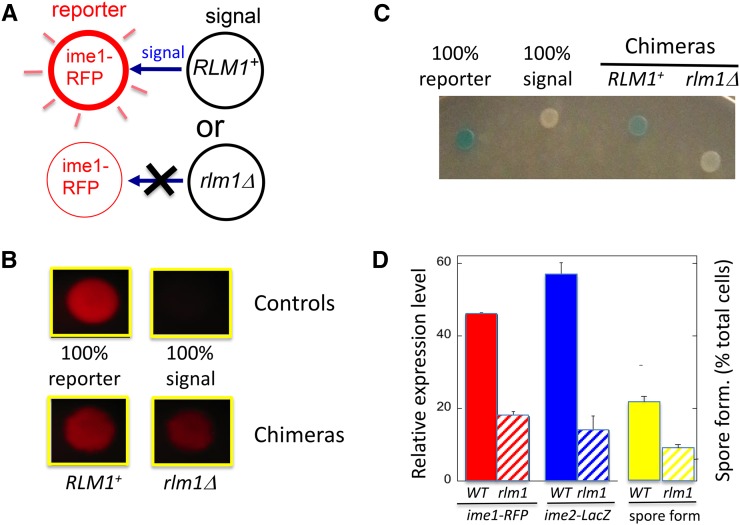Figure 4.
Rlm1 promotes IME expression and spore formation by a cell-nonautonomous mechanism. (A) Diagram of chimeric colony assay for testing cell autonomy. Chimeric colonies contain equal numbers of reporter cells (left), which carry a reporter allele (e.g., ime1Δ-RFP), and signal cells (right), which lack the reporter. If the genotype of the signal cell affects the response from the reporter cells, the corresponding gene must regulate the response via a nonautonomous mechanism. (B) Effect of rlm1Δ allele on ime1Δ-RFP expression in chimeric colonies. Top two control colonies contain either only the RFP reporter strain (left, SH4414) or only the RLM1+ signal strain (right, SH5071). Bottom two colonies contain chimeras with a mixture of the reporter strain and either RLM1+ (left, SH5071) or rlm1Δ (right, SH5072) signal strains. (C) Effect of rlm1Δ allele on ime2Δ-lacZ expression in chimeric colonies. (From left to right) The colonies contain only the ime2Δ-lacZ reporter strain (SH3825), only the RLM1+ signal strain (SH3883), an RLM1+ chimera (equal mixture of SH3825 and SH3883), and an rlm1Δ chimera (equal mixture of SH3825 and SH4783) (n =4). (D) Quantification of response in RLM1+ (solid bars) or rlm1Δ (hatched bars) chimeric colonies: reporter cells measure either ime1Δ-RFP expression as in B (left, red; n = 5), ime2Δ-lacZ expression as in C (center, blue) or spore formation (right, yellow; n = 3), with the SPO+ reporter strain being the RLM1+ IME2+ strain (SH3881) and the signal strains being the SPO− strains SH3883 (ime2Δ RLM1+) and SH4783 (ime2Δ rlm1Δ) (n = 3).

